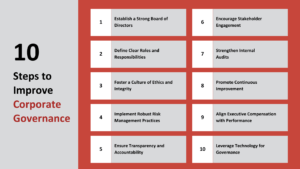10 Steps to Improve Corporate Governance

Imagine an organization where everyone knows their roles, tasks are completed smoothly, and there’s a strong sense of trust and transparency. Meetings are productive, decisions are made quickly and fairly, and everyone is aligned with the company’s goals. This is what strong corporate governance looks like, supported by effective GRC (Governance, Risk, and Compliance) solutions.
Good corporate governance goes beyond just meeting regulatory requirements; it brings numerous benefits like improved company culture, increased accountability, and the ability to spot potential issues early. More importantly, it shows investors that the business is organized and dedicated to their best interests. Therefore, organizations must understand how to ensure good corporate governance.
Grant Thornton’s Corporate Governance Review states, “The best-performing companies are embracing governance activities, not as separate compliance needs, but as business essentials that are fundamentally linked: risks to strategy, strategy to purpose, and reward to what matters to all.” This highlights that effective corporate governance integrates governance activities with business strategy and purpose.
A key finding from the report is the difference between just performing governance tasks and actively seeking good corporate governance, especially in risk management. While 89% of FTSE 350 boards discussed identifying risks, only 30% focused on mitigating them. Proactive risk management is where real value and competitive advantage lie.
Good corporate governance isn’t just about ticking boxes to comply with regulations. It’s about understanding and using these requirements to enhance the organization’s operations and position it for success.
At iTech, we believe that effective governance is within reach for every organization. Thus, to help you, we present ten simple steps to enhance governance, achieve streamlined processes, experience enhanced transparency, and foster a culture of accountability.

Step 1: Establish a Strong Board of Directors
A robust board of directors is the cornerstone of effective corporate governance. Develop a rigorous recruitment process to attract diverse and skilled individuals. Use a mix of professional networks, recruitment agencies, and public advertisements. Conduct regular training sessions on governance, industry trends, and regulatory changes. Implement annual performance evaluations for board members to ensure they are contributing effectively.
Example: Schedule quarterly training sessions on emerging governance issues and ensure board members attend industry conferences to stay updated.
Step 2: Define Clear Roles and Responsibilities
Clear delineation of roles and responsibilities between the board, management, and other stakeholders is crucial. Create a detailed governance (GRC) framework document outlining the roles and responsibilities of everyone involved. Develop and circulate an updated organizational chart to all employees. Ensure every role has a clear job description that is regularly reviewed and updated.
Example: Conduct workshops with each department to clarify roles and responsibilities and provide a comprehensive manual accessible to all employees.
Step 3: Foster a Culture of Ethics and Integrity
Ethical behavior must be at the heart of corporate governance. Develop a comprehensive code of conduct and ensure it is easily accessible to all employees. Conduct mandatory ethics training sessions for all employees annually. Implement a robust policy management to protect employees who report unethical behavior.
Example: Set up an anonymous reporting system for unethical practices and ensure it is regularly communicated to employees.
Step 4: Implement Robust Risk Management Practices
Effective risk management is vital for sustainable corporate governance. Conduct regular risk assessments to identify potential risks. Develop detailed risk mitigation plans for identified risks. Use risk management software to monitor and report risks in real time.
Example: Establish a risk committee that meets monthly to review risk assessments and update mitigation plans.
Step 5: Ensure Transparency and Accountability
Transparency builds trust with stakeholders. Regularly communicate the organization’s performance, strategies, and risks through clear and comprehensive reports. Establish accountability mechanisms, such as performance reviews and audits, to ensure everyone is responsible for their actions.
Example: Publish quarterly financial reports and hold town hall meetings to discuss organizational performance with employees and stakeholders.
Step 6: Encourage Stakeholder Engagement
Engaging with stakeholders, including shareholders, employees, customers, and the community, is essential for good governance. Conduct regular surveys to gather feedback from stakeholders. Organize regular forums and meetings to discuss their concerns and suggestions. Develop a clear communication strategy to inform stakeholders about key decisions and developments.
Example: Create an online portal where stakeholders can submit feedback and track the organization’s responses and actions.
Step 7: Strengthen Internal Audits
Strong internal audits are necessary to safeguard the organization’s assets and ensure the accuracy of financial reporting. Develop and implement comprehensive internal control policies. Conduct regular internal audits to assess the effectiveness of internal controls. Use technology to monitor internal audits and address weaknesses promptly and continuously.
Example: Implement a control management system that alerts for deviations from established control procedures.
Step 8: Promote Continuous Improvement
Corporate governance is not a one-time effort but a continuous process. Regularly review and update governance practices to adapt to new challenges and opportunities. Encourage a culture of learning and improvement, where feedback is valued, and best practices are continuously adopted.
Example: Conduct annual governance audits and use the findings to improve policies and procedures.
Step 9: Align Executive Compensation with Performance
Executive compensation should be aligned with the organization’s performance and strategic goals. Develop clear and transparent criteria for performance-based incentives, ensuring executives are rewarded for achieving long-term objectives.
Example: Implement a balanced scorecard approach to evaluate executive performance based on financial and non-financial metrics.
Step 10: Leverage Technology for Governance
Technology can significantly enhance corporate governance practices. Implement governance, risk, and compliance (GRC) software to streamline processes, improve data accuracy, and facilitate real-time reporting. Leveraging technology helps in efficient risk management, compliance monitoring, and decision-making.
Example: Use GRC software to automate compliance reporting and risk management, providing real-time insights and alerts.
In a nutshell
Strong corporate governance is the foundation of a successful and sustainable organization. By establishing a strong board of directors, defining clear roles and responsibilities, fostering a culture of ethics, implementing robust risk management practices, ensuring transparency and accountability, encouraging stakeholder engagement, strengthening internal controls, promoting continuous improvement, aligning executive compensation with performance, and leveraging technology, organizations can significantly enhance their governance practices. These steps ensure compliance with laws and regulations and build a culture of trust, integrity, and excellence, leading to long-term success and sustainability.
So, start today by evaluating your current governance practices and identifying areas for improvement. Engage with your board, management, and stakeholders to develop a comprehensive governance strategy that aligns with your organization’s goals and values. Remember, strong corporate governance is not just about compliance—it’s about building a resilient, ethical, and successful organization for the future.
For organizations seeking to enhance their governance practices, iTech, utilizing IBM OpenPages, offers comprehensive GRC solutions that integrate seamlessly with your business strategy. Partner with iTech to ensure your governance framework not only meets regulatory standards but also drives your organization towards long-term success and sustainability.
